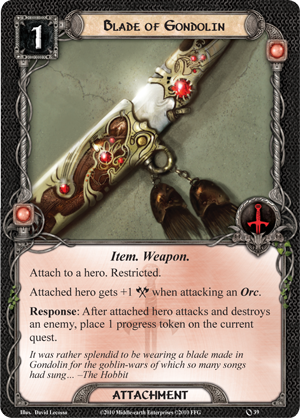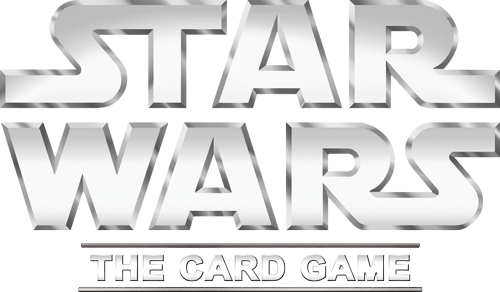From the FFG article here:

 “If Gandalf would go before us with a bright flame, he might melt a path for you,” said Legolas. The storm had troubled him little, and he alone of the Company remained still light of heart.
“If Gandalf would go before us with a bright flame, he might melt a path for you,” said Legolas. The storm had troubled him little, and he alone of the Company remained still light of heart.“If Elves could fly over mountains, they might fetch the Sun to save us,” answered Gandalf. “But I must have something to work on. I cannot burn snow.”
“Well,” said Boromir, “when heads are at a loss bodies must serve, as we say in my country. The strongest of us must seek a way.”
–J.R.R. Tolkien, The Fellowship of the Ring
Two weeks ago, we explored how different combinations of heroes might each tackle the unique challenges of The Lord of the Rings: The Card Game. Decks take on different personalities and the game plays differently depending on your choice of heroes in your starting fellowship.
We believe this variety is a good thing. Players have different personalities, and they should be able to build and play decks that suit them. In solo games, a player’s deck establishes the tenor of the entire game. In multiplayer games, however, a player’s deck influences part of the game, but not the entirety of it. It’s impossible for a player to change the shape of the entire game with just one deck among two, three, or four, but players may certainly still play decks that suit their styles. In fact, multiplayer offers more room for specialized roles than solo play.
Today, we look at some of the current multiplayer archetypes and explore some of the cards that make help these decks quest successfully.
What’s your style?
As the player card and hero pools for The Lord of the Rings: The Card Game expand, players gain more options for deck customization, allowing for greater focus on a theme or role than the pre-constructed decks from the Core Setoffer. Many of these reconfigured decks benefit from the combination of heroes and player cards from two or more spheres of influence, combining complementary cards from each sphere to reinforce the deck’s overall purpose.
Below, we identify a few multi-sphere deck archetypes and look at how the heroes play into each of them:
TANK
Heroes: Gimli (Core Set, 4), Boromir (The Dead Marshes, 95), Frodo (Conflict at the Carrock, 25)
Heroes: Gimli (Core Set, 4), Boromir (The Dead Marshes, 95), Frodo (Conflict at the Carrock, 25)

The tank’s role is to engage as many enemies as possible, and destroy them. Frodo may seem out of place, but he acts as the “armor” that allows the player to engage more than he can safely block. Absorbing enemies is just as important a part of the tank’s duties as is destroying them.
As long as you don’t hit fifty threat, you generally want a higher threat than your teammates so that you’ll draw enemies out of the staging area before they’re forced to engage your friends. Boromir and Frodo can both raise your threat. Just be careful that you don’t put yourself at risk too early. The Galadhrim’s Greeting (Core Set, 46) is an expensive event for the deck, but it can help you stay in the game longer to support your friends.
Also, allies with Sentinel can help you better defend your teammates. The Gondorian Spearman (Core Set, 29) and Winged Guardian (The Hunt for Gollum, 4) can both block attacks directed at your teammates, and a Feint (Core Set, 34) can come in handy, too. Meanwhile, as you focus on absorbing hits so that your teammates won’t, you can expect to suffer some casualties, making the Horn of Gondor (Core Set, 42) a perfect fit.

HEALER
Denethor (Core Set, 10), Eleanor (Core Set, 8), Glorfindel (Core Set, 11)
Denethor (Core Set, 10), Eleanor (Core Set, 8), Glorfindel (Core Set, 11)
The healer’s role is to keep the party alive, both by healing damage and by mitigating the dangers of the encounter deck. While other players focus on questing, attacking, and defending, the healer plays a quieter and subtler role away from the front lines and all the game’s primary action.
Denethor’s ability to scout the top card of the encounter deck is more useful in games with fewer players because he grants you information about a greater percentage of the encounter cards you’re due to face. On the other hand, Eleanor’s ability provides greater impact in games with more players, where you’ll face more cards and it’s more likely a single treachery card may steer your heroes off their course. Critical to your use of the deck is knowing when to use these heroes’ abilities, rather than keep them ready to support your teammates by defending against enemies.
Still, you can supplement these abilities with cards like A Test of Will (Core Set, 50) and Hasty Stroke (Core Set, 48) to lessen the impact of surprises from treachery and shadow effects. And when your scouting fails, you can still help your teammates recover quickly from their bruises with Glorfindel and cards like Lore of Imladris (Core Set, 63), Daughter of the Nimrodel (Core Set, 58), and Beorn’s Hospitality (Core Set, 68).
Apart from Glorfindel, your heroes aren’t much good in a fight, but they are clever. Even though you want to direct your focus elsewhere, if you can prompt some Infighting (A Journey to Rhosgobel, 58) among your foes, you may be able to help your party finish off wounded enemies.
ADVENTURER
Aragorn (Core Set, 1), Éowyn (Core Set, 7), Imrahil (A Journey to Rhosgobel, 50)
Aragorn (Core Set, 1), Éowyn (Core Set, 7), Imrahil (A Journey to Rhosgobel, 50)

The adventurer’s role is to focus as much on questing as possible, and a starting fellowship of Aragorn, Éowyn, and Imrahil can quest with the best of them. Players have long debated whether or not Éowyn is critical to success in the game. She’s not “critical,” but it’s hard to argue that her four Willpower isn’t helpful. In a four-player game, she can quest for as much as eight Willpower if each player sacrifices a card to fuel her ability.
Aragorn and Imrahil fit the deck because they both share two Willpower and the ability to ready themselves after questing. Aragorn readies if he pays a resource from his pool, making him an excellent candidate to serve as the Steward of Gondor (Core Set, 26), and Imrahil readies whenever a character leaves play, meaning that he can react swiftly if your Snowbourn Scout (Core Set, 16) or Westfold Horse-Breaker (Core Set, 6) is struck down by an enemy or rides off to ready another hero.
Plus, Aragorn is Middle-earth’s greatest ranger and the rightful heir to Elendil’s throne. Accordingly, he gets a little extra love and benefit from some cards like Celebrían’s Stone (Core Set, 27), which not only gives him two extra Willpower but also adds a Spirit icon. This means the fellowship can play two-cost allies like Westfold Horse-Breaker and Escort from Edoras (A Journey to Rhosgobel, 55) each turn, rather than needing to save for them. With their extra Willpower, the quester can race forward to put progress toward your quest each turn.



























